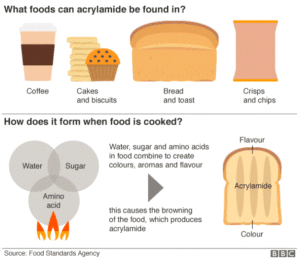British government tells home cooks: do something about acrylamide
As a distraction from Brexit, perhaps, the British government has just launched a new anti-acrylamide campaign aimed at home cooks: “Go for Gold.”
By Gold, it is referring to the preferred color of toast: the lighter the color, the less acrylamide, a carcinogen formed when foods containing sugars and the amino acid asparagine are cooked at high temperatures. This is a Maillard reaction, which causes baked, fried, and toasted foods to turn attractively brown and delicious.
As the BBC explains,

The response? Critics immediately complained that evidence linking acrylamide to cancer is weak and that this campaign is unnecessarily scary and distracting from real public health problems such as food insecurity and obesity.
I’ve written about Acrylamide several times in the past. Here’s what I said in 2009: “Acrylamide, sigh”:
I don’t know what to say about acrylamide. Acrylamide is the powerful carcinogen that gets formed when carbohydrates and proteins are cooked together at high temperature, as in dark toast, French fries, and potato chips. I just can’t figure out how bad it is, and I like my toast well toasted. But: Canada recently added acrylamide to its list of toxic substances. The European Union has just listed it as a hazardous chemical “of high concern.”
It’s better to avoid it, I guess. But is this a number one priority for a national public health campaign?

